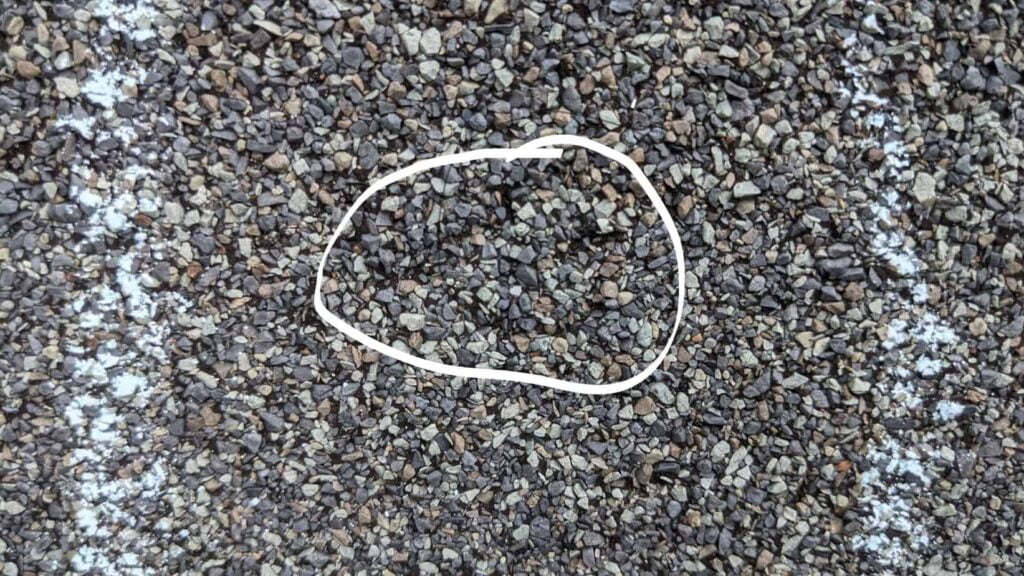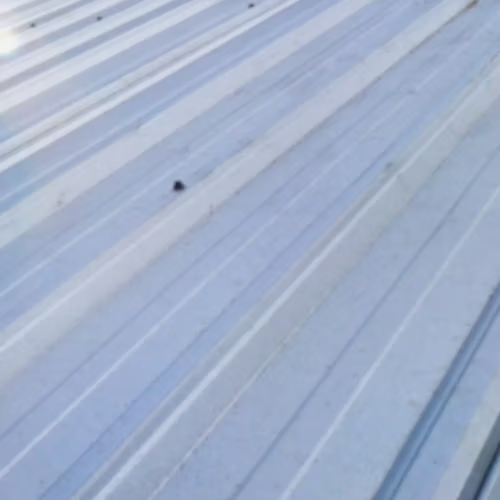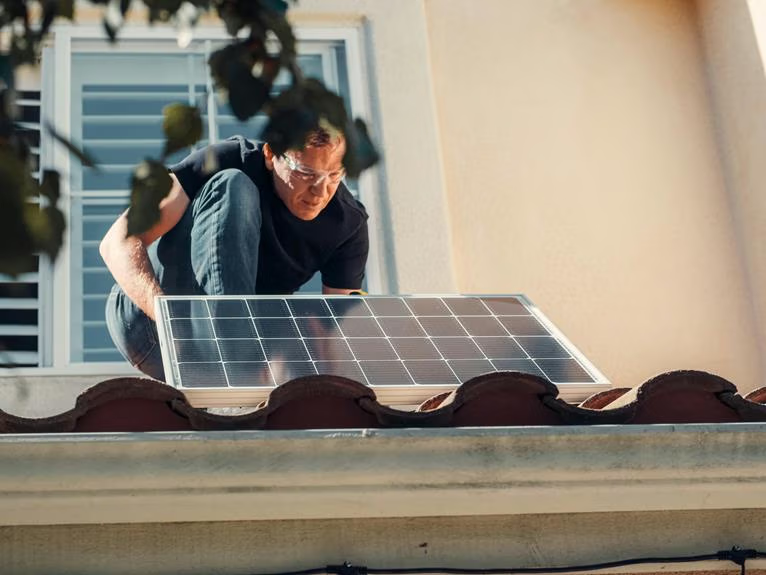
Hail Damage Roof Inspection: A Comprehensive Guide
Some hail damage is easy to distinguish, like the crack in the shingle above in the picture. But some roof hail damages can only be detected by having an experienced professional roofer conduct a hail damage roof inspection because they can’t easily be detected from the ground.
If you’re a home or business owner in the greater Minneapolis area, you need to know this to protect yourself against mild to severe damages that could occur to your home if hail damage—even mild damage is left to worsen after your roof has been hit by a hailstorm.
This blog will get you up to speed on everything you need to know about roof hail damage, and let you know why Sellers Roofing Company – New Brighton is the best local Twin Cities roofer to call on for free hail damage roof inspection after a storm hit and you think your roof might have been compromised.

Understanding Hail Damage
Hail can cause significant damage to roofs, compromising their integrity and leading to costly repairs. In this section, we will explore how to identify hail damage on different types of shingles and the various types of damage they can sustain.
How to Tell if Your Roof Received Hail Damage:
Different shingle types can exhibit different types of damage when impacted by hail. Here are some common types of shingles and the damages they may experience:
- Asphalt Shingles: Look for random, circular areas of granule loss, cracks, or splits in the shingle surface.
- Wood Shingles/Shakes: Check for split or cracked shingles, dents, or sharp edges.
- Metal Roofs: Look for dents or dimples on the metal panels, paint chipping or scratching, and loose fasteners.
- Slate or Tile Roofs:Inspect for cracked or broken tiles, granule loss, or fractures in the slate.

Types of Roof Hail Damage:
When a hailstorm hits, it can wreak havoc on your roof, leading to various types of roof hail damage.
In this section, we will explore the different types of hail damage that can occur and provide insights on how to conduct a thorough hail damage roof inspection. Identifying and understanding the different types of damages is important for home and business owners in Minneapolis because it helps them in assessing the condition of your roof and determining the necessary repairs.
Types of Hail Damage
- Shingle Damage: One of the most common types of hail damage occurs to shingles. Depending on the intensity of the hailstorm, shingles can experience different forms of damage, including:
- Granule Loss: Hail impacts can dislodge granules from the shingles, exposing the underlying material to potential damage from the elements.
- Bruising or Dents: Hailstones can leave bruises or dents on the shingle surface, compromising its integrity.
- Cracks or Fractures: Severe hailstorms can cause cracks or fractures in the shingles, leading to leaks and further deterioration.
- Structural Damage: Hail damage is not limited to shingles alone; it can also affect the structural components of your roof, such as:
- Roof Deck: Hailstones can crack or puncture the roof deck, weakening its structure and potentially causing leaks.
- Flashing: Hail impacts can dislodge or damage the flashing around chimneys, vents, skylights, and other roof penetrations, compromising their ability to prevent water infiltration.
- Gutters and Downspouts: Hailstones can dent or damage gutters and downspouts, affecting their functionality and causing water drainage issues.
How to Do a Hail Damage Roof Inspection
To assess the extent of hail damage to your roof, it’s essential to conduct a thorough inspection. Here are the key steps to follow:
- Safety First: Before inspecting your roof, prioritize safety. Ensure that you have stable footing, use appropriate personal protective equipment, and avoid inspecting the roof during inclement weather or immediately after a hailstorm.
- Exterior Inspection: Start by examining the exterior of your roof for visible signs of hail damage. Look for dented or cracked shingles, missing granules, or any other irregularities. Pay attention to specific areas, such as valleys and ridges, which are prone to increased hail impact.
- Interior Inspection: Check the interior of your home for any signs of water leaks or stains on the ceilings or walls. Hail damage may result in roof leaks that manifest as water stains inside your home.
- Document the Damage: Take detailed photographs or videos of the hail damage you observe during the inspection. These visual records will serve as essential evidence when filing an insurance claim.
- Consult with Professionals: If you are unsure about the extent of the damage or need a more comprehensive assessment, it’s recommended to consult with professional roofing contractors experienced in hail damage inspections. They can provide expert insights and help determine the necessary repairs.
By understanding the various types of hail damage and performing a thorough roof inspection, you can assess the condition of your roof accurately. Remember, timely identification and documentation of hail damage are vital for initiating the repair process and filing an insurance claim, if necessary.
Performing a Thorough Roof Inspection:
Performing a Thorough Roof Inspection:
To perform a thorough roof inspection for hail damage, follow these general guidelines:
- Safety First: Ensure your safety by using appropriate protective gear and accessing the roof safely.
- Inspect from a Distance First: Start by inspecting the roof from a distance, looking for any obvious signs of damage.
- Inspect Closer: Then, get closer and examine individual shingles or tiles for specific signs of hail impact.
- Pay Attention to Detail: Pay attention to details such as granule loss, dents, cracks, or fractures on the surface.
- Document Findings: Document any findings through photographs and detailed notes to support your insurance claim.
Residential Roof Hail Damage Inspection Checklist:
- Inspect all shingle surfaces for signs of impact, including granule loss, cracks, or splits.
- Check flashing around chimneys, vents, and skylights for dents or damage.
- Examine gutters and downspouts for accumulated granules or dents caused by hail impact.
- Look for water stains or leaks in the attic or interior ceilings as potential indicators of roof damage.
Commercial Roof Hail Damage Inspection Checklist:
- Inspect the roof membrane for punctures, tears, or cuts caused by hail impact
- Examine flashings, including drip edges, parapet walls, and equipment curbs, for dents or damage.
- Check for loose or displaced ballast or roofing materials on low-slope roofs.
- Assess the condition of metal coping, fascia, and gutters for dents or dimples.
What other components on the roof are inspected for storm damage?
1. Is there any other type of damage that roofing contractors check for after inspecting the roof vents and metal components?
Yes, roofing contractors also check for damage to other areas such as the gutters and downspouts, which can be dented or damaged by hail, affecting their functionality and causing water drainage issues.
2. Does hail damage to metal components indicate damage in other areas of the roof?
Yes, if hail has caused dents in the metal components of the roof, such as the roof flashing, it is likely that there is damage in other areas of the roof as well.
3. What other metal components on the roof are inspected for damage?
In addition to roof vents, roofing contractors inspect the roof flashing and any other metal components on the roof for dents and dings caused by hail.
4. What signs of damage do roofing contractors look for in roof vents?
Roofing contractors look for dents in roof vents that clearly indicate signs of hail damage.
5.What are the most common areas that show signs of damage on a roof after a storm?
After a storm, the most common areas that show signs of damage on a roof are the roof flashing and roof vents.
Performing a thorough roof inspection is crucial for accurately assessing hail damage and documenting evidence for insurance purposes. By following these checklists, you can ensure a comprehensive inspection that covers key areas of concern for both residential and commercial roofs.
Collateral Damage to Objects on the Ground Level:
Another thing you want to think about when a hailstorm hits in Minneapolis is assessing any potential damage to vehicles, windows, and outdoor structures that may have happened during the storm. Because when a hailstorm strikes, it’s not just your roof that can suffer damage. Other objects on the ground level, such as vehicles, windows, and outdoor structures, are also vulnerable. Here’s what you need to know:
- Vehicles: Hailstones can cause dents, scratches, cracked windshields, and broken mirrors on vehicles. Assess the extent of the damage and document it properly. Take photographs from different angles, noting the size of the hailstones and the resulting damage.
- Windows: Hail can shatter or crack windows, compromising their integrity. Inspect all windows on your property for signs of damage, such as chips, cracks, or shattered glass. Ensure that you document the damage thoroughly, as it may be covered under your homeowner’s insurance policy.
- Outdoor Structures: Structures such as sheds, gazebos, fences, and patio furniture can also be affected by hail. Check for dents, broken pieces, or any other visible damage. Take photographs to document the condition before and after the hailstorm, as this can support your insurance claim.
Documenting collateral damage is essential when filing an insurance claim for hail damage. Here’s why:
- Claim Validation: Proper documentation of collateral damage strengthens your case when filing an insurance claim. It provides concrete evidence of the hailstorm’s impact and the resulting damage to your property.
- Comprehensive Coverage: Insurance companies may provide coverage for collateral damage caused by hail. By documenting this damage, you increase the chances of receiving the appropriate compensation for repairs or replacements.
- Repair and Replacement Costs: Collateral damage can result in significant repair or replacement expenses. Documenting the damage helps ensure that you receive the necessary compensation to restore your property to its pre-hailstorm condition.
The Importance of Documenting Collateral Damage for Insurance Claims: Step-by-Step Guide to Filing an Insurance Claim
When a hailstorm strikes, it’s not just your roof that can suffer damage. Collateral damage to objects on the ground level, such as vehicles, windows, and outdoor structures, can also occur. It’s essential to document this collateral damage properly to ensure a smooth insurance claim process. Here’s why documenting collateral damage is important:
- Validates Your Claim: Documenting collateral damage provides concrete evidence that the hailstorm caused additional harm to your property. This strengthens your claim by demonstrating the extent of the damage incurred beyond just the roof.
- Insurance Coverage: Homeowner’s insurance policies may cover collateral damage caused by hailstorms. By documenting the damage, you can substantiate your claim and increase the chances of receiving compensation for the repairs or replacements needed.
- Comprehensive Assessment: Proper documentation allows insurance adjusters to conduct a comprehensive assessment of the overall damage. It enables them to accurately evaluate the financial impact of the hailstorm and determine the appropriate compensation for all affected aspects of your property.
- Repair Costs: Collateral damage can result in significant repair or replacement costs. By documenting the damage, you provide a clear record of the expenses incurred, allowing the insurance company to assess the extent of the financial burden caused by the hailstorm.
Filing an insurance claim for throughout the claims process for reference and reference purposes.
Step-by-Step: Filing an Insurance Claim
Filing an insurance claim for collateral damage requires a systematic approach. Here’s a step-by-step guide to help you navigate the process:
- Assess the Damage: Immediately after the hailstorm, carefully inspect your property for collateral damage. Take note of any vehicles, windows, or outdoor structures that have been affected. Look for dents, cracks, shattered glass, or any visible signs of damage.
- Document the Damage: Capture clear photographs or videos of the collateral damage from different angles. Ensure that the images clearly show the extent and nature of the damage. This visual evidence will be crucial in supporting your claim.
- Gather Supporting Documentation: Collect any relevant documentation related to the damaged items. This may include repair or replacement estimates, receipts for previous repairs, and any other evidence that helps establish the pre-damage condition and the financial impact of the hailstorm.
- Review Your Insurance Policy: Familiarize yourself with the coverage provided by your homeowner’s insurance policy for collateral damage. Take note of any specific requirements or exclusions related to the items affected.
- Contact Your Insurance Company: Notify your insurance company about the collateral damage as soon as possible. Provide them with a detailed description of the damage, including the date, time, and location of the hailstorm. Inform them that you have documented the damage with photographs and other supporting evidence.
- File a Claim: Obtain the necessary claim form from your insurance company and complete it accurately and thoroughly. Include a detailed description of the collateral damage and attach all supporting documentation, including the photographs and estimates.
- Submit the Claim: Submit the completed claim form and all supporting documentation to your insurance company. Keep copies of everything for your records. Ensure that you maintain open lines of communication with the insurance company and promptly respond to any requests for additional information.
By following these steps and providing comprehensive documentation, you enhance your chances of a successful insurance claim for collateral damage caused by a hailstorm. Remember to keep track of all communication with your insurance company throughout the claims process for reference and reference purposes.
Necessary Documentation and Evidence for a Successful Claim
To increase the chances of a successful claim, you need to provide the insurance company with the necessary documentation and evidence. Here are some essential items to include:
Photographs and Videos: Capture clear visual evidence of the hail damage to your roof and property. Take photos from different angles to show the extent and severity of the damage. Videos can also be useful in documenting the condition before and after the hailstorm.
Roofing Contractor’s Inspection Report: A professional inspection report from a reputable roofing contractor is crucial. It provides an expert assessment of the hail damage, including detailed descriptions and recommended repairs. This report serves as valuable evidence to support your claim.
Receipts and Invoices: If you have previously made repairs or improvements to your roof, gather receipts and invoices as proof of these expenses. This documentation helps establish the pre-damage condition and the value of the repairs needed due to the hailstorm.
Insurance Policy Information: Include a copy of your homeowner’s insurance policy, highlighting the sections related to hail damage coverage. This will help the insurance company understand the terms and conditions of your policy.
Personal Documentation: Keep a record of any communication with your insurance company, including the date, time, and details of conversations or emails. This ensures you have a clear record of your interactions throughout the claims process.
By providing comprehensive documentation and evidence, you can strengthen your hail damage insurance claim and increase the likelihood of a successful outcome.
Does Homeowner’s Insurance Cover Hail Damage?
When it comes to hail damage, understanding the coverage provided by your homeowner’s insurance policy is crucial. Here are key aspects to consider:
Differentiating between Actual Cash Value (ACV) and Replacement Cost Value (RCV):
- Actual Cash Value (ACV): ACV refers to the current value of your damaged property, taking into account depreciation over time. If your policy provides ACV coverage for hail damage, the insurance company will reimburse you for the cost of repairs or replacement, minus the depreciation. This means you may receive a settlement that reflects the reduced value of your damaged property.
- Replacement Cost Value (RCV): RCV coverage ensures that the insurance company will cover the full cost of repairing or replacing the damaged property without factoring in depreciation. With RCV coverage, you will receive reimbursement for the actual cost to restore your property to its pre-damage condition, up to the policy limit.
Factors Influencing Coverage Eligibility:
Several factors can influence your eligibility for coverage when it comes to hail damage. It’s important to review your policy and consider the following:
- Policy Terms and Conditions: Carefully review your homeowner’s insurance policy to understand the specific terms and conditions related to hail damage coverage. Look for any limitations, exclusions, or deductibles associated with hail damage claims.
- Geographic Location: The location of your property plays a significant role in determining coverage eligibility. Some regions are more prone to hailstorms, and insurance policies may have specific provisions for properties in these areas. Make sure to be aware of any geographic considerations mentioned in your policy.
- Deductibles: Your homeowner’s insurance policy will specify the deductible amount you need to pay before the insurance coverage kicks in. The deductible is the portion of the claim that you are responsible for covering out of pocket. Ensure you understand your deductible amount and how it applies to hail damage claims.
- Endorsements or Additional Coverage: Some insurance policies offer endorsements or additional coverage options specifically designed for hail damage. These endorsements may provide higher coverage limits, reduced deductibles, or additional benefits. Review your policy to see if any endorsements are available and consider adding them if necessary.
It is essential to consult with your insurance provider or agent to fully understand the coverage provided by your policy and how it applies to hail damage. They can help clarify any questions you may have and provide guidance on the specific terms and conditions of your coverage.
By understanding the differences between ACV and RCV coverage and considering the factors influencing coverage eligibility, you can make informed decisions when it comes to filing a hail damage insurance claim. Remember to review your policy regularly and ensure that it provides adequate coverage for your property based on your specific needs and location.
Can Hail Roof Damage Be Repaired?
When hailstorms strike, they can cause significant damage to roofs. However, not all hail damage requires a full roof replacement. Here’s what you need to know about assessing the extent of hail damage and determining if repairs are possible:
- Visual Inspection: Conduct a visual inspection of your roof to assess the damage. Look for signs of hail impact such as dents, cracks, bruising, or missing granules on the shingles. Examine the flashing, vents, gutters, and other roofing components for any visible damage.
- Age and Condition of the Roof: Consider the age and overall condition of your roof. Newer roofs or roofs in good condition may be more likely to withstand hail damage without significant issues. Older roofs, especially those nearing the end of their lifespan, may be more susceptible to damage and may require closer inspection and potential repairs.
- Severity of Damage: Evaluate the severity of the hail damage. Minor cosmetic damage, such as a few dented shingles, may be repairable. However, if the damage is extensive, with multiple compromised shingles or structural issues, a roof replacement might be necessary.
- Leaks or Water Damage: Check for any signs of leaks or water damage inside your home. If you notice water stains, ceiling discoloration, or visible water intrusion, it may indicate more significant roof damage. In such cases, repairs alone might not be sufficient, and a roof replacement may be required to ensure the integrity of your home.
- Consult with Roofing Professionals: It is crucial to consult with experienced roofing professionals to assess the hail damage accurately. They have the expertise to evaluate the extent of the damage, identify underlying issues, and provide recommendations for repairs or replacements.
Roofing professionals will thoroughly inspect your roof, taking into account various factors such as the type of roofing material, the severity of damage, and the overall condition of the roof. They will provide an accurate assessment of the damage and guide you on the appropriate course of action.
Remember, hail damage can be deceptive, and even seemingly minor damage can compromise the long-term performance of your roof. It is always recommended to consult with professionals to ensure an accurate evaluation and avoid potential issues down the line.
By assessing the extent of hail damage and consulting with roofing professionals, you can determine whether your roof can be repaired or if a replacement is necessary. Addressing hail damage promptly and appropriately is essential to protect your home and maintain its structural integrity.
What is the process for filing a claim for storm damage to the roof?
- When filing a claim for storm damage to your roof, the process generally involves the following steps: Upon completing the inspection of your roof, the roofing contractor will assess whether there is evidence of storm damage. Based on their findings, they will provide you with their professional recommendation regarding the need to file a claim. If no damage is detected, they will suggest alternative solutions to address any issues your roof may have.
- In the event that the roofing contractor identifies storm damage, they will document it by taking pictures and explaining the extent of the damage to you. These pictures will serve as evidence to be submitted to your insurance company.
- Once the documentation is gathered, it is up to your insurance company to review and make a decision on approving or denying your claim. It’s important to note that your roofing contractor, although they can support your case, does not have the authority to approve your claim.
- The approval or denial of your claim rests solely with the insurance company’s adjuster. They will assess the extent of the damage, review the submitted evidence, and make a determination on the validity of your claim. It’s crucial to understand that while the process involves the roofing contractor exploring and documenting the damage, the final decision lies with your insurance company’s adjuster and the insurance company itself.
How do roofing contractors document storm damage to the roof?
1. Are there any additional damages that roofing contractors document besides the ones on the roof?
Yes, roofing contractors also document collateral damage on the ground as part of the evidence for the insurance claim.
2. How do roofing contractors mark the damage on the roof?
Roofing contractors use chalk to point out the damage on the roof. They circle the dents and dings on impacted areas for hail strikes on shingles, and they turn the chalk sideways and fill in the area to make the damage more noticeable for dents on roof vents.
3.What types of damage do roofing contractors look for when documenting storm damage to the roof?
Roofing contractors look for missing shingles, granule loss, hail marks, dents in metal, and anything else that appears to be possible storm damage.
FAQ’s
How we
can help you?
What happens after a storm damage roof inspection?
After completing a thorough inspection of your roof to assess storm damage, the roofing contractor will present you with their findings and recommendations regarding filing an insurance claim. If no damage is detected, they will advise against filing a claim and help explore alternative solutions to address any issues with your roof.
However, if they do find damage, they will provide you with detailed documentation, including photographs, and guide you through the subsequent steps. Additionally, they may share these images with your insurance company as part of the claim submission process.
It is important to note that the final decision on approving or denying your claim rests solely with your insurance company and the assigned adjuster. While your roofing contractor can support and advocate for you, they do not possess the authority to approve your claim.What areas of the roof are inspected for storm damage?
During a storm damage roof inspection, a roofing contractor carefully examines various areas of the roof for signs of damage caused by hail, wind, or other severe weather conditions. Some of the key areas that are thoroughly inspected include the gutters, shingles, roof flashing, and roof vents. The inspector pays close attention to identifying any dents, dings, or other evidence of damage on the gutters. They also assess the condition of the shingles, checking for any signs of wear, cracking, or displacement. Additionally, the inspection involves examining the roof flashing, which is the material used to seal the edges and joints of the roof against water penetration. The inspector ensures that the flashing is intact and free from any damage. Lastly, the roof vents are inspected for any signs of damage or displacement, as they play a crucial role in maintaining proper ventilation within the roofing system. Overall, these key areas are thoroughly assessed to determine the extent of storm damage and the necessary repairs or replacements needed.
What are the areas checked for collateral hail or wind damage from the ground level?
During a ground-level assessment for collateral hail or wind damage, the following areas and elements are thoroughly inspected:
1. Downspouts: Dents are examined specifically above 5 feet to rule out any potential damage caused by a lawnmower.
2. Garage Door: Any dings or strikes are carefully inspected for damage.
3. Window Screens: Holes in window screens are looked for as they could indicate hail or wind damage.
4. Painted Wood and Shutters: Dings on painted wood surfaces or shutters are assessed for any signs of impact.
5. Electric Meter, AC Unit, and Grill: Splatter marks or dings on these elements are checked closely for indications of hail or wind damage.
6. Soft Metals: Dents on items such as mailboxes and other soft metals found on the property are examined for damage.
7. Shingles on the Ground: Any shingles found on the ground are considered potential evidence of damage.
8. Siding: Missing siding is taken into account as it can be an outcome of hail or wind damage.
9. Granules by Downspouts: The presence of granules on the ground near downspouts is checked, as it could possibly be collateral hail damage.
By thoroughly inspecting these various areas and elements, a comprehensive assessment of collateral hail or wind damage from ground level can be achieved.How do roofing contractors prove that a roof has storm damage?
Roofing contractors establish the existence of storm damage on a roof by providing clear evidence that they carefully document. They adopt various methods to document the damage thoroughly. Firstly, they capture detailed photographs of the observed damage, which includes not only the damage to the roof itself but also any associated collateral damage on the ground. These photographs serve as visual proof and are essential for demonstrating the extent of the storm damage.
The contractors pay particular attention to documenting specific signs of storm damage. This may include taking photographs of missing shingles, which indicate the forceful impact of strong winds. They also record instances of granule loss, which occur when the protective layer of the shingles is eroded due to hail or heavy rain. Hail marks are another crucial indicator of storm damage, and contractors make sure to capture clear images showcasing these marks. Additionally, they focus on dents in metal components such as gutters or roof vents, as these indicate potential impact from hail or debris during a storm.
To make the recorded damage more evident, roofing contractors utilize chalk markings on the roof. This technique involves circling or highlighting dents and dings caused by hail strikes on the impacted areas. For dents on roof vents, contractors use chalk to fill in the affected area, making the damage more noticeable and easily identifiable. These chalk markings not only serve as a physical representation of the damage but also aid in presenting a comprehensive account of the storm-related issues found on the roof.
The collection of photographs and chalk markings serves as conclusive proof, which is then submitted to the insurance company for thorough evaluation. These documented pieces of evidence provide a transparent representation of the storm damage incurred and play a paramount role in enabling the necessary insurance claims to be processed accurately. Ultimately, through meticulous documentation and the utilization of visual evidence, roofing contractors effectively establish the presence of storm damage on a roof.What does a roofing contractor inspect and look for during a storm damage roof inspection?
During a storm damage roof inspection, a roofing contractor thoroughly inspects various areas to identify any signs of damage caused by the storm. Here are the key areas they typically focus on:
1. Gutters: The contractor examines the gutters for any dents, dings, or other visible damage. They also look for an accumulation of granules in the gutters, which may indicate compromised shingle integrity.
2. Shingles: The condition of the shingles is carefully examined. The contractor checks for missing, lifted, or creased shingles, which are common signs of wind damage. For hail damage, they look for dents or dings large enough to potentially cause harm to the shingles. They also look for signs of granule loss, which can occur due to impact from hail or wind.
3. Roof Flashing and Vents: Roof vents are assessed for dents that may indicate hail damage. Additionally, the contractor inspects roof flashing and other metal components for any signs of dings or dents. If hail has caused damage to the metal, it suggests that other areas of the roof may also be affected.
During the inspection process, the roofing contractor takes pictures of the storm damage, including any collateral damage on the ground and the roof itself. To make the damage more visible, they may use chalk to mark hail strikes on shingles or fill in dents on roof vents. These images are then shared with the insurance company for documentation purposes.
After completing the inspection, the contractor presents evidence of the storm damage to the homeowner and advises whether or not to file a claim with the insurance company. It’s important to note that while the roofing contractor can provide recommendations, they don’t have the authority to approve insurance claims. Only the adjuster and the insurance company have the power to make claim decisions.What happens during a storm damage roof inspection?
During a storm damage roof inspection, several crucial steps are taken by roofing contractors to thoroughly assess the condition of your roof. The process typically begins with a visual inspection conducted at ground level, where the contractor searches for any collateral damage that may indicate potential roof damage. This includes checking for dents in downspouts, damage to garage doors, holes in window screens, dings on painted wood or shutters, splatter marks or dents on electric meters, AC units, or grills, mailbox dents, missing siding, and granules on the ground near downspouts.
After examining the property for collateral damage, the roofing contractor proceeds to inspect the roof itself. They carefully examine gutters, shingles, and other roof components for signs of hail, wind, or other storm-related damage. This involves checking for dents or dings in the gutters, assessing the condition of shingles for any missing, lifted, or creased ones, and inspecting roof flashing and vents for damage.
Throughout the inspection, the roofing contractor takes detailed photographs of any damage they find as evidence. Furthermore, they mark the areas of damage on the roof using chalk or a similar method. These photographs and markings serve as proof of the storm damage and are crucial for any insurance claims that may be filed.
Once the inspection is complete, the contractor presents you with the evidence of storm damage and provides a recommendation on whether or not to file an insurance claim. If damage is confirmed, they can assist you throughout the claims process. They will share the photographs and documented evidence with your insurance company, who will then review and decide whether to approve or deny the claim.
If you decide to proceed with filing a claim, the roofing contractor can offer guidance and support to ensure a smooth process. They will be available to answer any questions you may have, provide additional necessary documentation, and assist you in navigating any further steps required to complete the claim.





